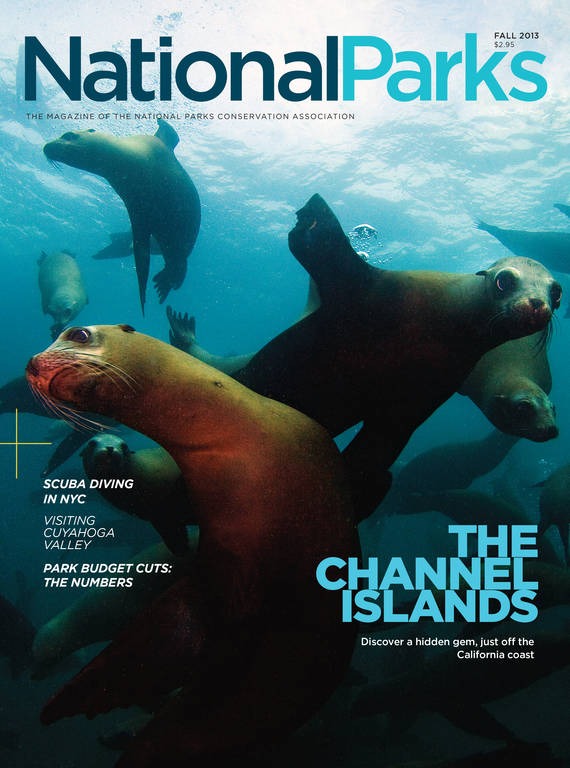Fall 2013
Night and Day
After 30 years of intense habitat restoration on the Channel Islands, the island night lizard might be ready to come off the endangered species list.
Forty years ago, vast swaths of the Channel Islands looked more like an eroded desert than a national park. Decades of ranching and grazing and the introduction of non-native species had devastated the natural landscape—a landscape once so rich and diverse that it was dubbed “America’s Galapagos.”
It wasn’t just the scenery that suffered. Many of the 145 plant and animal populations unique to the islands took a nosedive, too. Among the most charismatic of that bunch was the island night lizard, originally thought to be nocturnal (it’s actually just secretive). The species lives up to 30 years, gives birth to live young (versus laying eggs like most reptiles), and boasts some of the most vibrant camouflage in the reptile world, thanks to colorful surroundings. Found nowhere on Earth but three of the eight Channel Islands (Santa Barbara, San Clemente, and San Nicolas), the lizards are extremely vulnerable to predation—barn owls and American kestrels find them especially tasty. So when dense, scrubby hiding places started disappearing across the islands, biologists worried that the lizards might start disappearing, too.
The U.S. Fish and Wildlife Service responded in 1977 by listing the species as threatened. And so began an intense, cooperative effort between the National Park Service and the U.S. Navy, which owns and manages two of the islands where the lizard occurs (not part of Channel Islands National Park), to restore the land to its original state. They spent decades removing feral cats (originally ranchers’ pets) that preyed on small native animals like the island night lizard and contributed to the extinction of the Santa Barbara Island song sparrow. They also eradicated invasive goats, sheep, and rabbits that, well, multiplied like rabbits. “Removing non-native grazers from a piece of land is one of the biggest restoration actions you could possibly take,” says Tim Coonan, a biologist at Channel Islands National Park. “In a lot of situations, the ecosystem will just start to recover on its own.”
And that’s exactly what happened on the islands. Slowly, the land began to heal, and native vegetation began stretching new roots into old territories.
Fast-forward to the 1990s, when land managers started conducting annual population counts and stumbling on surprising data: “Every year we would count island night lizards, and they weren’t declining at all; if anything, their numbers were increasing,” Coonan says. It turns out that these lizards thrive at extremely high densities on incredibly small parcels of land—sometimes at more than 1,000 individuals per acre, depending on the vegetation. (This finding is yet another rarity in the reptile world, one that biologists attribute to the species’ sluggish metabolism, which decreases its need for copious amounts of food and space.)
This discovery had bigger implications than simply broadening knowledge of the species alone. It made biologists question whether the island night lizard was ever actually floundering to begin with. “It’s entirely possible,” says Coonan, “that there were always more island night lizards on the ground than we originally thought.”

National Parks
You can read this and other stories about history, nature, culture, art, conservation, travel, science and more in National Parks magazine. Your tax-deductible membership donation of $25 or more entitles…
See more ›But managing for the species as if it were on the brink wasn’t necessarily a bad thing, he says. It helped spur a much-needed landscape restoration, which ultimately benefited other species, and the visitor experience, too. It also helped to establish some peace of mind. “There was a sense of relief when we realized [the lizards] had not been too severely affected by human activities on the islands,” Coonan says. “If you can cross one thing off the list of things to worry about, that’s good, because the list is long.”
In February, the Fish and Wildlife Service drove that success home by proposing to take the island night lizard off the endangered species list. A recent count tallied roughly 21 million individuals on San Clemente Island, 15,000 on San Nicolas Island, and 17,000 on Santa Barbara Island within national park boundaries. As part of the delisting, land managers would be required to monitor the species for at least five more years, but the Park Service will monitor island night lizards on Santa Barbara in perpetuity. Because losing them, Coonan says, would completely throw off the natural balance of these islands, considering the lizards take up so much of the habitat and feed on so many different things—from boxthorn fruit to ground-dwelling spiders.
The Park Service is also working hard to make sure the species doesn’t fade into oblivion on the interpretive front, either. “Santa Barbara is one of our smallest islands, and it’s a little harder to get to, so we don’t have a ton of visitors,” Coonan says. “But we’ve been talking about island night lizards for decades. They’re part of our natural heritage, and some of that heritage has been lost over time, which is why this is a species we should cherish and treasure.”
About the author
-
 Amy Leinbach Marquis
Amy Leinbach MarquisAmy Leinbach Marquis is former associate editor at National Parks magazine.



